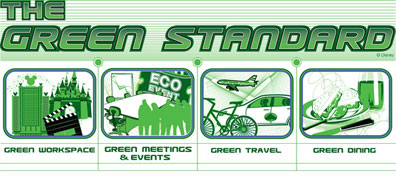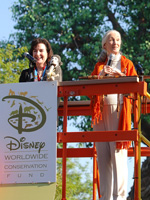Education and Action
Long-Term Goal #7: Inform, empower and activate employees, business partners and consumers to take positive action for the environment
Through the years, Disney's environmental efforts have touched the lives of millions of people directly and indirectly. Going forward, we will seek not just to build awareness but to empower and activate employees, business associates and consumers to take positive action for the environment. The focus for 2008 was on engaging employees at all levels, concentrating on leadership and engagement initiatives. In addition, we continued our strong tradition of inspirational programs for Guests and consumers, such as environmental specials on our networks and Disney's Environmentality Challenge school program.
Leadership Approach
Stakeholder Engagement
For many years, Disney has partnered with nongovernmental organizations (NGOs) such as Conservation International and The Nature Conservancy to develop and strengthen company strategies, programs and initiatives on environmental issues. Acknowledging the benefits of these relationships, Disney developed in 2008 a broad stakeholder engagement strategy designed to promote collaboration with key opinion leaders in the environmental community. These relationships helped inform and strengthen Disney's environmental strategies and long-term goals. We propose to build on these relationships by initiating a series of working groups comprised of academics, business associates and members of the NGO community to help guide policy decisions on topics such as GHG emissions and waste minimization.
Environmental Council
Disney's Environmental Council, formed in June 2007, includes senior executives from across Disney, ABC and ESPN and from around the world. The council is charged with developing and directing high-level environmental strategies and operational practices. Members are expected to attend quarterly meetings and achieve environmental targets in their respective areas. In 2008, the council led the development of long-term goals, medium-term targets, and the carbon reduction strategy. In addition, the council oversaw the development and implementation of The Green Standard, a company-wide employee directive aimed at integrating environmentally responsible practices into everyday business operations. Extending their commitment, council members have also formed subcommittees to strategize solutions for specific environmental topics, such as climate change and campaigns to inspire consumers.
Environmentality Summit
To engage a broader group of Disney leaders, the third Disney Environmentality Summit was held in June at Disney's Contemporary Resort, a Florida Green Lodging facility. The event brought together nearly 150 executives and environmental leaders from all businesses worldwide to address environmental issues, present and future, facing the company. President and Chief Executive Officer Bob Iger and Senior Executive Vice President and Chief Financial Officer Tom Staggs opened the Summit and set the stage for two days of in-depth discussion about environmental strategy, expectations for incorporating environmental stewardship into daily operations, strategic sourcing and supply chain management, employee engagement and emerging regulations. In addition, each Disney business segment shared its recent successes in a best practices showcase.
Green Teams
We have also implemented a "Green Teams" strategy, bringing together Cast Members from each segment to participate in or lead environmental initiatives in their respective areas. The Green Teams are responsible for championing the implementation of environmental initiatives in their business units. Successful Green Teams are in place throughout the company.

|
The Green Standard encourages employees to minimize their environmental impact at work.
|
Employee Initiatives
On Earth Day 2008, Disney rolled out a new program, the Green Standard, for employees and Cast Members. Aimed at reducing the company's operational impact on the environment, the Green Standard asks that every Cast Member and employee make simple environmentally minded changes in four key areas: workspace, meetings and events, travel and dining. The first two areas, or phases, were launched in 2008 and the second two will launch in 2009.
Green Workspace Standards
Key components of the Green Standard for the workplace:
- Don't Talk Trash: Recycle! Recycle cans, bottles, paper, cardboard, cell phones, electronics, electronic media (DVD, CD), landscape waste and construction debris.
- Reduce & Refill! Eliminate individual plastic water bottle use in backstage operations and offices.
- Double Up! Print and make copies using both sides of the page.
- Branch Out! Use a minimum of 30% recycled-content paper for everyday printing and copying.
- Take a Power Break! Turn off unnecessary lights.
- Be a Low-Rider! Minimize driving alone during work hours by using environmentally friendly options such as teleconference, videoconference, carpools and public transit.
Green Meetings and Events Standards
Green Standard expectations for meetings and events include:
- Venue: Request that the meeting or event venue complete and return an environmental assessment checklist in advance of planning.
- Education: Educate staff, exhibitors and attendees to ensure participation in environmental initiatives that are in place at the event or meeting.
- Communication: Avoid printing materials and disseminate information electronically via email or a designated website.
- Product: When promotional products are necessary, choose recycled-content or reusable options. As an attendee, accept only giveaways that you will use.
- Recycling: Provide highly visible recycling bins. As an attendee, look for opportunities to recycle.
- Food and Beverage: Request that food and beverages be served in bulk containers (e.g. condiments). Do not pre-pour beverages; offer pitchers or individual servings upon request.
Guest Inspiration

|
|
Walt Disney World hosted the Jane Goodall Global Youth Summit in April 2008, where youth from six continents gathered to address critical issues facing our planet.
|
We recognize that Disney has unique opportunities to influence and inspire its many fans, consumers and Guests to take action for the environment. Therefore, we implemented numerous environmental education opportunities throughout Disney's parks and resorts. These touch-points give Guests a unique perspective on environmental issues, some of which include biodiversity, waste management and energy conservation.
- Disney's Animal Kingdom and The Seas with Nemo and Friends at Epcot at the Walt Disney World Resort inspire Guests to care for wildlife and wild places. In fact, each year, Cast Members share more than 3.9 million conservation messages with Guests and provide intimate backstage experiences for approximately 20,000 youths and adults.
- The 2008 Jane Goodall Global Youth Summit invited 100 youth leaders from six continents and 28 countries to Walt Disney World to address some of the critical issues facing the planet. Disney has been a long-time supporter of the Jane Goodall Institute and its youth leadership efforts, and played both a sponsorship and programming role in this event. The group and Dr. Goodall also helped celebrate a decade of dedication to conservation at the tenth anniversary of Disney's Animal Kingdom.
- In Brazil, the Peter Pan DVD was launched with a tree-planting promotion. As a result of this program and the enthusiastic consumer response, Disney sponsored the planting of 60,000 trees in the Mata Atlantica Rainforest.
- Since 2005, ESPN's X Games has achieved major environmental success through the X Games Environmentality program and other green initiatives. In 2008, X Games 14 achieved an impressive 84% waste diversion rate from composting and recycling efforts.

|
|
Sleeping Beauty and Smokey the Bear join forces to protect forests from wildfires.
|
- ESPN's annual awards program, the ESPYs, featured recycling, clean energy
sources and the use of sustainable materials and featured a series of messages featuring the Muppets to educate attendees about the environmental initiatives taking place at the event.
- Disney's Environmentality Challenge, the company's flagship environmental education program for young people, has seen 15 years of success. To date, some 1.5 million children have participated in the program by pledging to make small changes and completing hundreds of campus and community environmental projects.
- Disney Studios continued a successful tradition of using classic Disney animated features to share important environmental messages with public audiences. On June 1, Disney in partnership with the AdCouncil and the National Forest/Smokey the Bear, launched a wildfire prevention PSA featuring Sleeping Beauty. The PSA appeared in TV and radio spots, online and on outdoor billboards and posters reaching millions of consumers.



